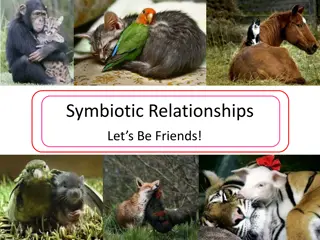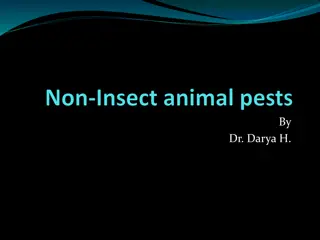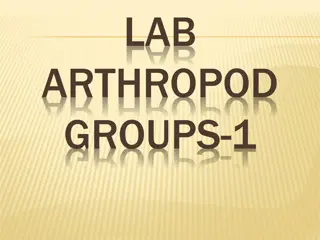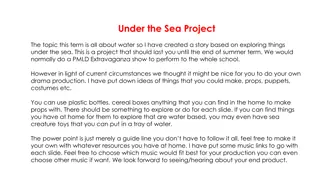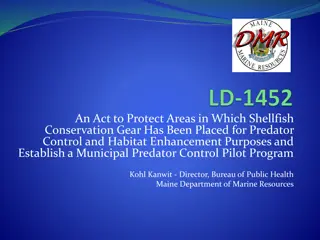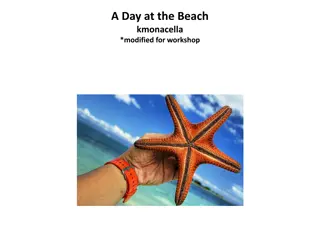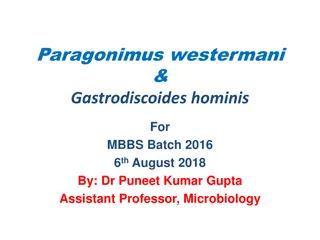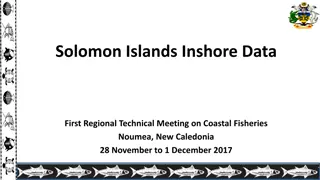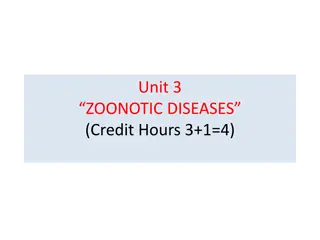Understanding Symbiotic Relationships in Nature
Symbiotic relationships are intricate connections between different species where they benefit from each other. Mutualism, commensalism, and parasitism showcase the diverse ways organisms interact. Examples like decorator crabs with sponges, proboscis butterflies with flowers, and barnacles on whale
1 views • 22 slides
Understanding Non-Insect Pests in Agriculture
In this lecture, we delve into important non-insect pests affecting agriculture, such as nematodes, mites, snails, slugs, crabs, millipedes, birds, rodents, and more. Learn about their systematic positions, damages they cause, and characteristics. Explore the world of millipedes and centipedes, thei
0 views • 15 slides
Overview of Arthropods: Classification and Characteristics
Arthropods are a diverse group of invertebrates characterized by segmented bodies, appendages, and chitinous exoskeletons. They belong to the Phylum Arthropoda and are classified into four important classes: Myriapoda, Crustacea, Arachnida, and Insecta. This article explores the unique features of e
0 views • 18 slides
Under the Sea Adventure - DIY Drama Production Project
Dive into a creative DIY drama production project themed around exploring the wonders under the sea. Use everyday household items to craft props, puppets, and costumes for a captivating underwater journey. Let your imagination run wild as you bring the ocean to life in your very own show. Explore se
0 views • 22 slides
An Act to Protect Areas for Predator Control and Habitat Enhancement Purposes
LD1452 is a legislative act aimed at protecting areas where shellfish conservation gear is placed for predator control and habitat enhancement. The act establishes a municipal predator control pilot program to address the impact of green crabs on soft clam populations. It prohibits the molestation o
0 views • 25 slides
Fun Day at the Beach: Explore, Play, Enjoy!
Discover the joy of a day at the beach with activities like playing with sand toys, building sandcastles, hunting for seashells, and spotting marine life such as starfish and crabs. The beach offers endless opportunities for relaxation and fun in the sun.
0 views • 10 slides
Life on the Beach: Seagulls, Crabs, and Starfish
Seagulls, crabs, and starfish make the beach their home. Seagulls enjoy small fish, bread, and seaweed, running and flying swiftly. Crabs dine on shrimp, ocean plants, and small fish, scurrying on sand and in the ocean. Starfish, with their slow movements, feast on clams, oysters, and small fish. Di
0 views • 4 slides
Understanding Paragonimus westermani and Gastrodiscoides hominis Infections
Paragonimus westermani and Gastrodiscoides hominis are parasitic flatworms that infect humans primarily through the consumption of raw or undercooked crabs and crayfish. They can cause serious respiratory and CNS complications. The adult worms have distinct morphological characteristics and a comple
0 views • 29 slides
Insights into Data Collection and Fisheries Management in Solomon Islands Inshore Fisheries
Through a comprehensive overview of data collection methods and types related to inshore fisheries in the Solomon Islands, this report highlights various aspects such as marine product export and local purchase data, HAPIFIS data collection with socio-economic surveys, and research on key species li
0 views • 16 slides
Understanding Paragonimiasis: A Zoonotic Disease
Paragonimiasis is a zoonotic disease caused by the Paragonimus lung fluke, primarily transmitted to humans through consumption of raw or undercooked crabs or crayfish. The disease can lead to various symptoms ranging from mild cough and abdominal pain to more severe cases affecting the central nervo
0 views • 9 slides
